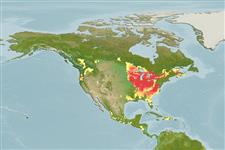Classification / Names
Common names from other countries
Main reference
Size / Weight / Age
Max length : 55.0 cm TL male/unsexed; (Ref. 40637); common length : 25.0 cm TL male/unsexed; (Ref. 556); max. published weight: 2.7 kg (Ref. 40637); max. reported age: 9 years (Ref. 59043)
Environment
Freshwater; brackish; demersal; depth range ? - 40 m (Ref. 1998)
Climate / Range
Temperate; ? - 37°C (Ref. 35682), preferred ?; 54°N - 25°N
Distribution
North America: Atlantic and Gulf Slope drainages from Nova Scotia and New Brunswick in Canada to Mobile Bay in Alabama in USA, and St. Lawrence-Great Lakes, Hudson Bay and Mississippi River basins from Quebec west to Saskatchewan in Canada and south to Louisiana, USA. Introduced into several countries. Several countries report adverse ecological impact after introduction. Asia: Iran and Turkey (Ref. 39702).
Countries | FAO areas | Ecosystems | Occurrences | Introductions
Short description
IUCN Red List Status (Ref. 115185)
Threat to humans
Potential pest
Human uses
Fisheries: minor commercial; aquaculture: commercial; gamefish: yes
Tools
Special reports
Download XML
Internet sources
Estimates of some properties based on models
Phylogenetic diversity index
PD50 = 0.5078 many relatives (e.g. carps) 0.5 - 2.0 few relatives (e.g. lungfishes)
Trophic Level
3.7 ±0.1 se; Based on diet studies.
Resilience
Medium, minimum population doubling time 1.4 - 4.4 years (K=0.47; tm=3; tmax=8)
Vulnerability
Low to moderate vulnerability (30 of 100)
Price category
